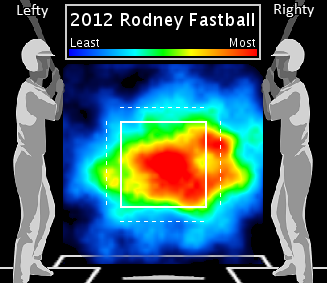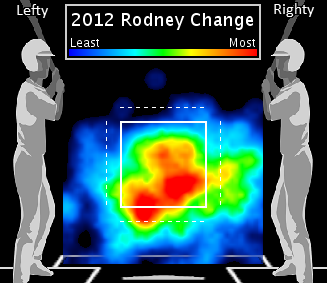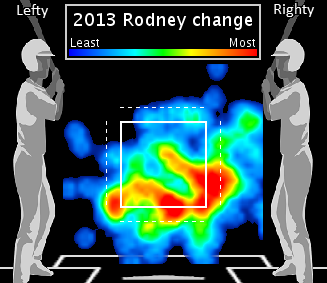The Fernando Rodney Difference
 Bill Chuck |
Bill Chuck |  Sunday, May 19, 2013 at 1:49PM
Sunday, May 19, 2013 at 1:49PM
It is uncommon for the Tampa Bay Rays to have a reliever to lead the team in saves for successive seasons.
Rays Saves leaders since 2000
| Player | SV | Year |
|---|---|---|
| Fernando Rodney | 48 | 2012 |
| Kyle Farnsworth | 25 | 2011 |
| Rafael Soriano | 45 | 2010 |
| J.P. Howell | 17 | 2009 |
| Troy Percival | 28 | 2008 |
| Alberto Reyes | 26 | 2007 |
| Tyler Walker | 10 | 2006 |
| Danys Baez | 41 | 2005 |
| Danys Baez | 30 | 2004 |
| Lance Carter | 26 | 2003 |
| Esteban Yan | 19 | 2002 |
| Esteban Yan | 22 | 2001 |
| Roberto Hernandez | 32 | 2000 |
Usually, the Rays anoint a new closer each season but this year Tampa went right back to Fernando Rodney who was successful for them last year converting 48 of 50 save opportunities.
But this season, he has already been denied shooting his imaginary arrow into the save-osphere, blowing three saves in 10 opportunities.
The ugliest blown save of the season may have occurred this past Thursday night when he entered the game with a 3-1 lead over the Boston Red Sox in the top of the 9th and issued a career-high three consecutive walks before Will Middlebrooks lined a bases-clearing double that blew the save and resulted in a 4-3 Rays loss.
The 2012 All-Star closer was missing the strike zone by a lot and over-throwing his fastball in the hopes of closing out this game.
2012 vs 2013
Rodney is a very different pitcher this season. Not only had Rodney led American League in saves in 2012 and he had a 0.78 ERA and a 0.777 WHIP. This season, he has a 5.28 ERA and a 1.761 WHIP.
- In 2012, he pitched 74.2 innings, allowed nine runs, walked 15, and he gave up two homers. In 2013, he has pitched 15.1 innings, allowed nine runs, walked 15, and he has given up two homers.
Rodney pitched for the Dominican Republic in the 2013 World Baseball Classic and you have to wonder if it took its toll in terms of velocity and control.
Rodney is a fastball/change-up pitcher
2012
In 2012, Rodney averaged 96 mph on his fastball, with a high of 100.4, and a low of 91.4. Batters hit .248 against it with two homers, 19 whiffs, and nine walks. 
In 2012, Rodney averaged 82.5 mph on his change, a 13.5 mph differential, with a high of 88.7, and a low of 78.2
Batters hit .070 against it with no homers, 55 whiffs, and five walks.

2013
In 2013, Rodney has averaged 95.9 mph on his fastball, basically the same as last season, but you can see his location is nowhere as effective as last season, drifting lower in the zone.
He has hit a high of 100.1, and a low of 90.5. Batters are hitting .365 against it with one homer, six whiffs, and six walks.

In 2013, Rodney has averaged 84.2 mph on his change, an 11.7 mph differential, with a high of 84.2, and a low of 78.7
Batters have hit .094 against it with one homer, 17 whiffs, and eight walks.

As you can see, the reduced speed differential and less precise placement of the change is making both his change and fastball less effective.
Let's quantify that further
- In 2012, batters swung at 50.1% of Rodney's change-ups; in 2013, it's 46.4%.
- In 2012, 70.4% of Rodney's change-ups were strikes or in play; in 2013, it's 60.6%.
- In 2012, batters swung at 50.1% of Rodney's change-ups; in 2013, it's 46.4%.
- In 2012, batters chased 42.5% of Rodney's change-ups; in 2013, it's 35.1%.
- In 2012, 40.6% of Rodney's change-ups were called strikes; in 2013, it's 28.4%.
You get the feeling that Joe Maddon and Jim Hickey, the brilliant pitching coach for the Rays, won't let this continue much further. Invariably, the Rays don't have room for error and can't afford a shaky closer. If Rodney is unable to sharpen his control and spread the speed differential between his two pitches, don't be surprised if the Rays seek an alternative closer.

Reader Comments